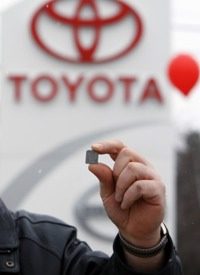
The unrelenting attacks on Toyota are a metaphor for similar attacks on the free-market economy by its detractors.
Up until August, 2009, Toyota had become the premier automobile manufacturer in the world. Through its “relentless pursuit of perfection” (Toyota’s Lexus brand’s marketing slogan), Toyota enjoyed increasing sales and profitability through its successful efforts to serve its customers better than its competition.
In August, a horrendous car crash involving a family driving a Lexus automobile killed the driver, Mark Saylor, a California Highway Patrol officer, his wife and daughter, and his brother-in-law. A recording of a passenger’s frantic 911 call, lasting 52 seconds, was broadcast throughout the media and pushed Toyota into the unwelcome and unaccustomed spotlight of negative public attention. That attention continues today.
A careful review of the cause of the accident by the National Highway Traffic Safety Administration revealed no mechanical or electronic malfunctions. What they did find “was that the design of the accelerator pedal allowed it to become easily entrapped in the groove of the rubber all-weather floor mat if the rubber mat was not properly secured with at least one of the two retaining hooks.” The car was a loaner from the Lexus dealership while Saylor’s own automobile was being serviced. The previous driver of the loaner told the dealer that the floor mat had in fact hit the pedal.
Saylor was unable to slow the car because “with the engine throttle plate open, the vacuum power assist of the braking system cannot be replenished and the effectiveness of the brakes is reduced significantly.” NHTSA researchers said that stopping distances “increased from less than 200 feet to more than 1,000 feet.” In addition, it only took 30 pounds of pressure on the brake pedal to bring the car to a halt when the brake system was operating normally, but in the extraordinary circumstances of the Saylor accident, “brake pedal force in excess of 150 pounds [would have been] required to stop the vehicle.”
Officials also indicated that Saylor probably had a problem turning off the engine because the vehicle he was driving used a “start button” instead of an ignition key which “removes the ability to instantaneously shut off the engine in the event of an emergency while the vehicle is in motion.” In order to stop the engine, the start button would have to have been depressed for three seconds — a safety measure provided by Toyota in this vehicle to prevent the engine from being shut off by mistake.
The NHTSA had investigated complaints about unintended acceleration in early 2004 but closed the investigation in July of that year because investigators “had found no pattern of safety problems.”
Over the next two years, additional similar complaints were investigated, with similar results. Toyota itself could find no defects in the vehicles involved. Christopher Tinto, a Toyota liason to the NHTSA, wrote, “There is no factor or trend indicating that a vehicle or component defect exists.”
And then the Saylor accident took center stage. Upon completing their investigation of the accident, the agency published their findings on September 13, indicating that the accident “was caused by floor-mat pedal entrapment.” On September 26, Toyota recalled all vehicles (approximately 55,000) affected by the all-weather-floor mats, and issued a warning to all of its customers either to remove or properly secure those mats.
On September 25, 2009, after the NHTSA investigated another accident involving a similar brake failure, it told Toyota to “address the defect in the pedal design.” On October 5, Toyota issued a recall for 3.8 million vehicles to fix that problem.
On January 19 of this year, Toyota told the new NHTSA chief David Strickland that they knew of the problem with its gas pedals, whereupon Strickland got “steamed” and threatened to use his agency’s full authority (including subpoenas, fines, and demands to stop manufacturing automobiles) unless Toyota addressed the issue more fully. On January 21, Toyota ordered the recall of another 2.3 million vehicles for fixes. Strickland ordered Toyota to stop selling the affected vehicles until a solution was found. Toyota recalled another 1.1 vehicles for repairs.
The prompt responses were indicative of the culture of Toyota. According to Anna Bernasek, author of The Economics of Integrity, “From the start, Toyota was all about quality and catching problems. That culture has really built the brand. Toyota became synonymous with quality. It goes back to its philosophy that it is concerned with the best way to deliver value to the customer, to the shareholder, to the dealer and to every person involved with Toyota. It focused on giving the customer what they wanted honestly and openly.”
The whole thing with Toyota and quality is that Toyota delivered on what they promised. That forms a bond of trust with the customer. And it took decades to build that bond. That culture pervaded every aspect of the company. Toyota set everything from the factory floor to the internal organization to focus on and to deal with problems as they arise.
When asked about the recalls, Bernasek responded: “Toyota has gone out of its way to put the customer first. I think the difference in this case — specifically the pedal and the accelerator — is that there is no ‘smoking gun’ about what is wrong. They have been criticized as slow to respond. But Toyota has had all its engineers on it, and they have not been able to find a major problem. There hasn’t been anything definitively wrong. I think what exacerbated the situation was that spectacular crash when the fellow was calling 911. I think Toyota didn’t understand how that can catch people’s imaginations.”
The Obama administration has increased pressure on the company as well. Transportation Secretary Ray LaHood said, “My advice is if anybody owns one of these vehicles is to stop driving it and take it to a Toyota dealer because they believe they have the fix for it.” (Emphasis added.) LaHood later said that had been a “misstatement,” but went on to say, “Our people will hold Toyota’s feet to the fire to make sure they are going to do everything they said they were going to do to make the vehicles safe.” LaHood indicated that he was going to call the president of Toyota personally about the recalls. And Toyota’s North American CEO Yoshimi Inaba will shortly appear before the House Oversight Committee where both LaHood and Strickland can be expected to grill him mercilessly.
The media’s relentless attention on Toyota and its recalls have caused some to complain, calling it “one of the most irresponsible and destructive bouts of media thuggery in history.” Reference was made to the article in Time magazine, “Toyota’s Safety Problems: A Checkered History.” The writer for National Post summarized that article by saying, “Over 25 years, until October 2009, the magazine lists 12 incidents in which officials [from NHTSA] investigated and essentially found nothing.”
Dave Zoia, editorial director at WardsAuto.com, said “It’s important … that they … make sure there isn’t a perception out there that they’re ganging up on Toyota." Governors of Kentucky, Indiana, Mississippi and Alabama have sent a letter asking that Toyota get a “responsible and fair response from the federal government. Toyota must put the safety of drivers first and foremost. However, they deserve a level and reasonable response from the federal government — one that is not tainted by the federal government’s financial interest in some of Toyota’s competitors.”
Investors Business Daily put things into perspective: “Begin by understanding as clearly as possible that Toyotas are not dangerous. The best guess is that since 2001, 19 people have died in Toyotas with sticky accelerators. During that same period over 330,000 people died in traffic accidents.”
The lawyers are getting in line as well. E. Todd Tracy, an auto liability attorney from Dallas, said, “Toyota’s lack of engineering discipline and rush to become the world’s largest vehicle manufacturer will end up costing it billions of dollars in sales, recalls and lawsuits. (Emphasis added.)
Those costs are just beginning to be calculated. Toyota expects 100,000 fewer vehicle sales while they are fixing the problems. And Toyota’s stock, which peaked last fall at $92 a share, is currently trading at about $75. Other costs are involved too. As Investors Business Daily reminded its readers, “Toyota isn’t just a foreign company operating in the U.S. It’s a foreign investor with a $16 billion investment here and 30,000 American workers.”
And with 4,100 dealerships employing another 115,000 people, the continuing barrage of investigations and negative media attention could cause additional massive losses. Mack Ott, an economist formerly with the Federal Reserve and now an advisor at the Heartland Institute, says there are two reasons why foreign companies like investing in America: “One is [that] there’s generally a perception that when you come before the (legal) bench, the issue is not who you are and where you’re from, but the issue at hand. The other is U.S. openness [and] its innovative environment and higher return on investment.” To discourage such foreign investment, says IBD, by “political harassment and populist haymaking [is an] insane thing to do.”
Despite the incessant attacks and accusations, Toyota’s customers remain loyal to the company. A recent Rasmussen poll indicates that 59 percent of Americans “still hold at least a somewhat favorable view of Toyota even as the embattled automaker adds at least 300,000 2010 Prius models to the eight million cars it is already recalling worldwide over safety issues.” And local dealers are extending working hours and providing 24-hour hotlines to make sure their customers are served promptly. Groove Toyota in Englewood, Colorado, is servicing 80 vehicles a day, up from the usual daily volume of 50, and has extended its shop hours two hours — until 8 p.m. — to handle the repairs efficiently. The chief operating office at Groove, Bill Carmichael, said, “I’d say that the majority of customers are unshaken. You get some who are annoyed because they had to come in, but they leave satisfied and they still love their cars.” He added, “I don’t see a long-term impact on sales because Toyota has so much goodwill from so many years of supplying a great product.”
Tammy Darvish, the owner of four Toyota dealerships in the Washington, D.C., area, works nights answering her 24-hour hotline, and has extended shop hours six hours — until 5 a.m. When she was asked if she was afraid of losing customers over the recall issue, she said, “As long as we fix it right the first time and do whatever we can to make the inconvenience as minimal as possible, we can manage our customers. I sell GM cars also, and those customers would [change brands] for 10 bucks. But Toyota customers are loyal.”
I don’t want to minimize importance of any safety matter. But I think the media has made a sport out of sensationalizing something that is very common: a recall. I sell Chryslers, and they had 18 recalls last year. Did you read about any of those?
Toyota itself has been very active in countering the barrage of criticism. It is running a series of TV ads apologizing and promising to win back its customers’ trust. It’s also interviewing those who will be grilling them in Washington, to learn what they will be asking and how they can respond favorably.
In a microcosm, then, the travails of Toyota can be extended to the incessant media attacks on America’s market economy. With continuing education about how the system works when it is left alone, the business of America, just like Toyota, will continue to thrive and prosper.



